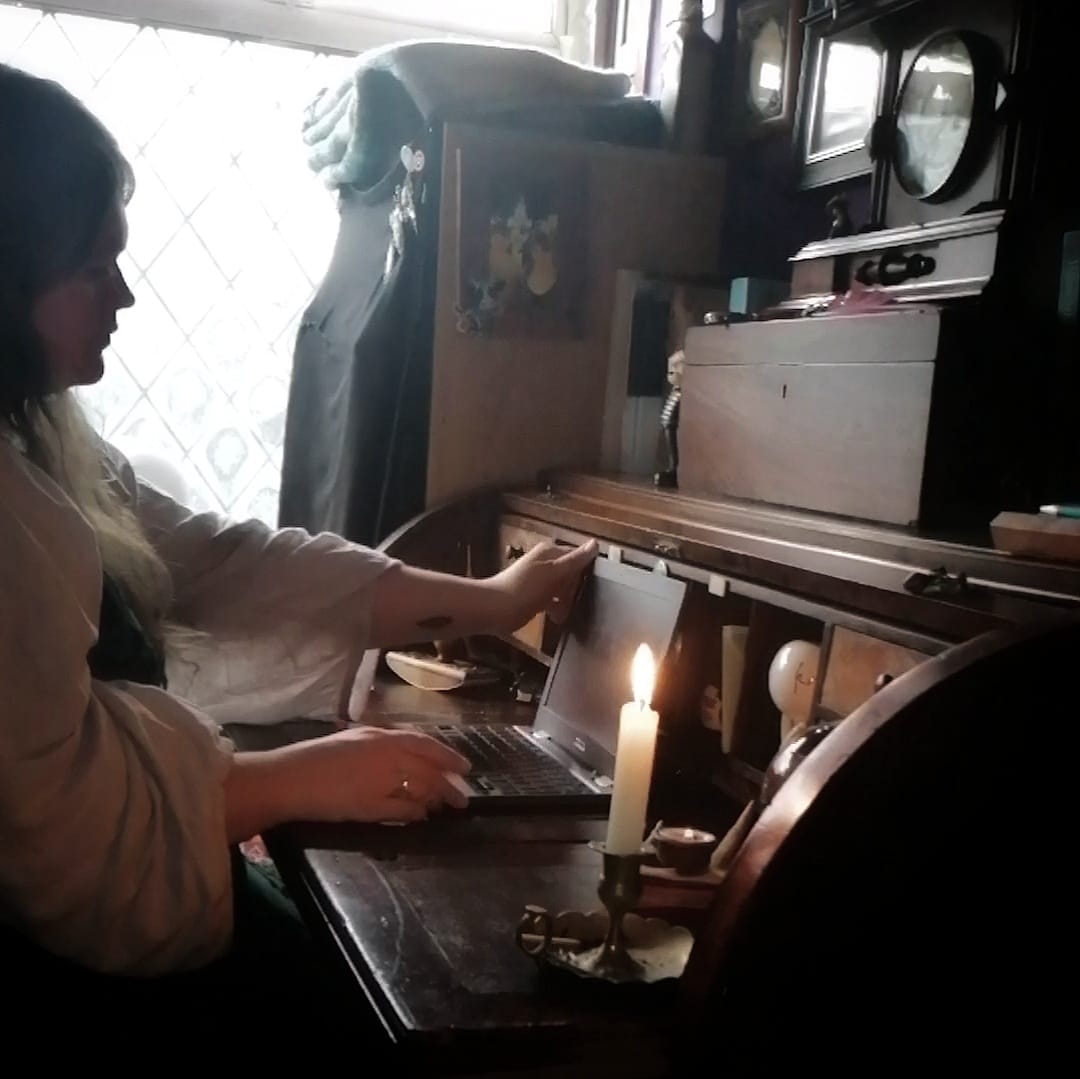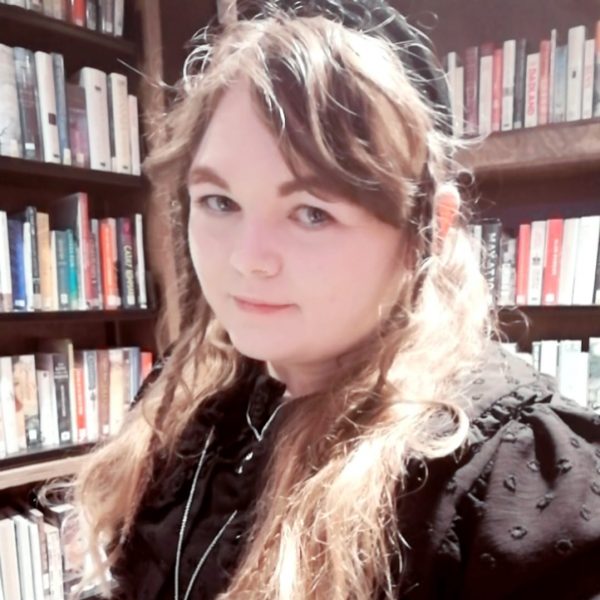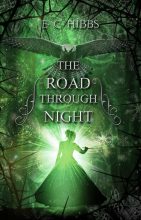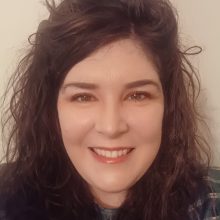The Road Through Night by E. C. Hibbs
What led you into writing?
It wasn’t so much that I was led into writing, as much as I realised it was something I needed to do. I’ve been writing since I was very young. I created my first short story when I was five years old, and my first novel when I was twelve. It was around that time that my parents and a handful of teachers began encouraging me to continue, and that coincided with my realisation that out of all the creative pursuits I enjoyed, writing was the one I could never give up. Drawing, painting, embroidery, calligraphy… all could be paused. But writing was my inner voice made real: a way for me to both escape the world and make sense of it. It was my ultimate way of connecting and communicating, and I’ve never ceased loving it.
How does a typical day look?
I get up early, and after my commute, I’ll make my way to the library. I usually have 90 minutes, during which I tend to focus on completing any admin or scheduling tasks. I head to my day job for 9 o’clock, then afterwards, I’ll spend the evening writing. That can take the form of working on a manuscript, editing, planning, or researching. On a good day, I can have up to three hours for this, and then I’ll go to bed, ready to do it all again!
The intensity of my day can vary, of course. When I’m really stuck in with a first draft, I like to spend as much time on it as I can, so I don’t lose the emotional flow. By contrast, if I’m not in the initial writing stage, I’m more relaxed with what I do and when.
In what ways do your characters test your abilities?
I think the most interesting thing with characters is finding the emotional connection to make them relatable. To that end, every character is an amplified offshoot of some facet which I have found within myself, or observed in others. However, many of the characters are very different from me. Some, I would relish in calling a friend; some, I wouldn’t want to associate with; some, I would run from like my life depended on it. Getting inside a head which is not entirely your own is fun, but tough. It forces you to look at things from different viewpoints, and to question what you would do in these situations. Psychologically, it’s a very powerful exercise.
Another way in which characters test me is when I have to learn more about them in order to depict them. Sometimes, that means picking up a new skill, or even doing a kind of method task to understand their physicality. Many years ago, for the Tragic Silence Series, I had a character from Budapest who was partially paralysed. Before I even started writing, I memorised a street map of the city, learned basic Hungarian, strapped a weight around my leg and practised walking with a cane. It was a very challenging experience, but it allowed me to write her in a way I never could have done otherwise.
What’s your setup?
I’m happy to write anywhere, but my workstation means so much to me. It’s a 120-year-old writing desk, adorned with antiques, ornaments, gifts from my readers and loved ones, calligraphy tools, and even real-life objects from my books. There are also a lot of candle holders, because I prefer to write by candlelight. It gives a lovely ambience, but another reason is because my eyes are very sensitive, and that soft warm glow is perfect for me.
When I work at my desk, I open the top, light my candles (and maybe my aurora ceiling light too,) get myself a drink of fruit squash or hot chocolate, and play some background music. That can be anything from metal to new age, or one of my book playlists on Spotify, but I tend to settle with soft classical ambience. All these things make me feel like my writing session itself becomes a story.
Simply put, it feels and looks like something out of a dark academia hobbit hole.

What lasting effects have your favourite authors had on your writing and style?
I grew up reading a lot of very varied work. By the time I was ten, I had read books which ranged from Roald Dahl to Charles Dickens, and I also really loved poetry and fairy tales. As I got older, I was drawn to writers with a lyrical tone to their work, especially when the story itself contained layers and intertextuality, and a dark edge which still felt palpable. I felt like those stories respected me as a reader, allowing me to connect with the characters and world, while also giving me room to go deeper if I wanted. That was the effect I drew from authors such as Philip Pullman, the Bronte sisters, Lemony Snicket and Marcus Sedgwick, and I try to weave the same feeling into my own work.
What do you do for inspiration?
Inspiration can come from many places: history, folklore, travelling, dreams, music, nature, people… It’s impossible for me to pin down the single moment when a story is born. But every day, I try to find inspiration in the little things – not just for writing, but for life in general, and one often informs the other. I’ll go for a walk in the woodland by my home. I’ll listen to music and maybe discover a new indie band. I’ll stroll through the cemetery and read as many of the headstones as I can. I’ll find a new book, or return to a beloved old one. I’ll visit a museum or art gallery, and try to get closer to the people who are immortalised there. No day is quite the same, and in turn, no two of my books are quite the same.
What repeating themes do you find yourself pulling into your stories?
On a surface level, there are always elements of history and/or folklore, laced with all kinds of fantasy. I find those things so inspiring: bottomless wells of possibilities. Because of that, I’ll happily write stories in various sub-genres: steampunk dystopia, renaissance coming-of-age, Arctic mythology adventure, a thriller vampire saga… and now, with my current series, a Gothic Victorian fairy tale re-imagining.
However, I feel that beneath the surface, other themes tend to come up, and are often focused on my characters. Many of them are disabled, or endure severe physical or mental trauma. There is a light cast on unassuming people, who might be brushed aside if their story had been a little bit different. And within all that, there is an undercurrent of intense strength. I know I put my characters through some horrible things – protagonists and antagonists alike – yet they endure. It’s that quiet power which we all have, but don’t realise until we must call upon it. I think it’s the most important theme which I always include: the acceptance and celebration of your own strength, however it presents, and along what unexpected paths it can take you.
How do you wind down?
In some respects, writing! When I was younger, it was what I would do after finishing my homework, and just because it’s now become a second job for me, it has never lost its joy. When I need to get away from the screen, however, I’ll read, watch a movie, update my diary, or go out with my partner or my friends. I like being creative, so I might do some art or calligraphy, sew some new clothes, or play the lyre. When I can, I also really enjoy travelling. My favourite part of the world is the Nordics, but there are so many places I would love to experience!
What sort of challenges do you regularly overcome while designing your world/setting?
I feel that the most insidious trap which a fantasy writer can fall into, is the notion that everything can be made up, and therefore, it requires no underlying structure or logic. If the plot and characters are going to land with readers, then everything needs to feel supported. So whenever I know an idea is going to mature into a finished story, I acknowledge that it will be a few years before I begin writing, because there is a lot of world-building and planning to be done.
This is actually one of my favourite parts of the entire process. I love losing myself in learning new things, growing my confidence, and understanding how the story will weave itself on this loom I’m discovering. However, the toughest part for me is making sure I’ve caught all the plot holes. The more complicated and layered the design, the more likely something will slip through the net. In the early stages, when I’m making my plan, I essentially interrogate my story into existence. I assume that every question I might ask is something a reader could also ask, and so, I will work at it until I can answer within the logic of the world I’ve created. It’s messy, beautiful chaos, but that’s all part of the fun!
What are you reading at the moment?
I’m currently devouring the fantastic Raven Rings Trilogy by Siri Pettersen. The series was originally published in Norwegian several years ago, and a friend of mine had insisted I read it, but that was hindered by an English translation not being available. However, at the start of 2025, I visited her in Norway, and was gifted a gorgeous hardback set of all three books in English! Now I’m finally reading it, I can say it was worth the wait! It’s a wonderful tale with layered characters and deep world-building inspired by Norse mythology, and I can’t recommend it highly enough.
What’s the most useful advice you could give to an aspiring author?
Not everyone will enjoy what you create. Not everyone will be supportive. You’ll have rejections, maybe a few sneers, and definitely days when it feels like you’re going nowhere. But you are always moving forward. When those days hit me, I remember my younger self, who only ever wanted one person to read her stories and enjoy them.
One person, and it’s you, as much as whoever will read your work. There are a lot of people out there, and I promise that the positives will outnumber the negatives. If you feel so passionately about your creation, you will not be the only person in the world who will see it. Be patient, find your crowd, don’t stop believing, and don’t forget why you started writing in the first place: because it’s something you love. And whether it’s today or one day, you can share that love with those who appreciate it.
Tell us about the book you’re promoting.
The Road Through Night is Book Two of The Nightland Quartet: a fusion of re-imagined fairy tales (a lot of them!), classic Gothic literature, and alternative Victorian history. It follows directly on from Book One: The Shade Between Shadows. The story takes place in an early United Kingdom, which also includes the country of Nightland: essentially the enchanted forest from the Brothers Grimm fairy tales, which is reached by passing through special portal cities such as London, York and Chester.
The series is told from the POV of Beatrice: a mute neurodivergent woman, who is half-English and half-Nightlander. In Book One, she was forced across the border, to be an indentured servant to the mysterious and alluring Prince Edward. After discovering a terrible secret in his castle, Beatrice and her friends, Anselm and Gretchen, have fled into the forest, and will soon come face-to-face with Edward’s enemy: the formidable Princess Rosahild. It’s a story which features found family, friends to lovers, Sapphic rep, ghostly birds and poisonous roses. And there’s also an action scene in Buckingham Palace!
👋 Hi! I run Author Interviews
As a new writer I found myself itching to contribute to a thriving, creative community, so I made Author Interviews and I've met loads of wonderful people in the process. You can buy my debut fantasy RINGLANDER: THE PATH AND THE WAY from Amazon.




